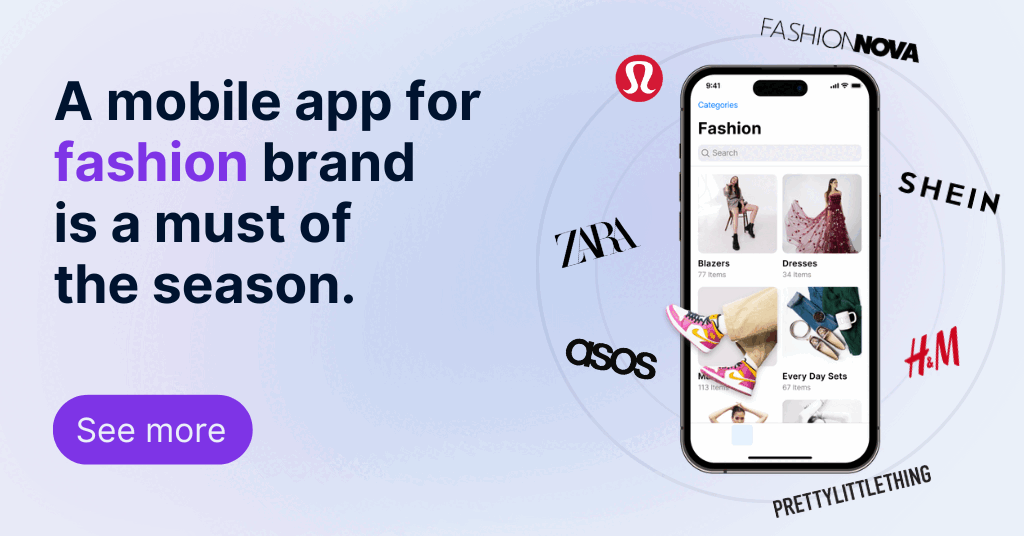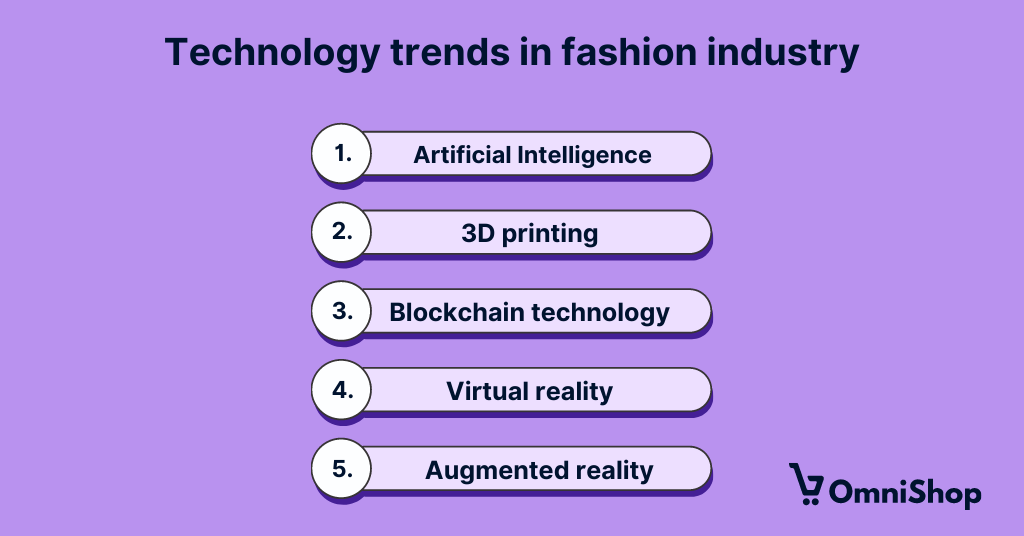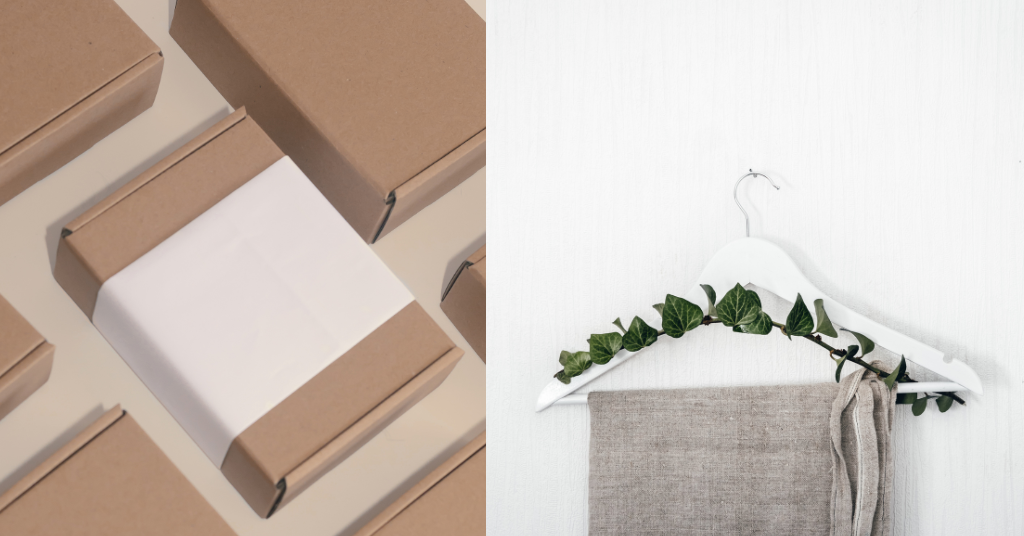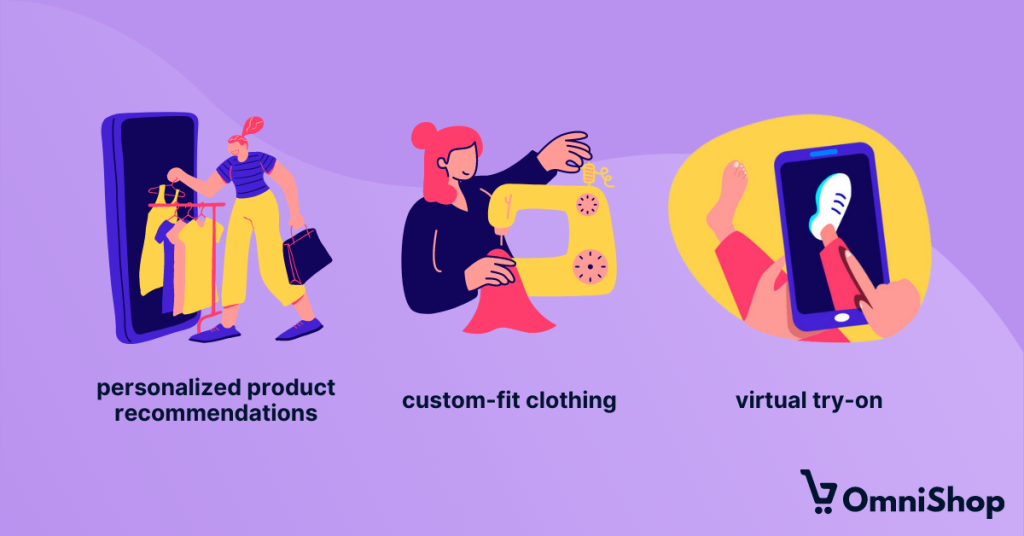
Fashion industry trends in 2025 – the ultimate list
Fashion’s always on the move, so the next year won’t surprise us. Online shopping is the norm now, all thanks to tech. If you’re in the e-commerce business, you know how quickly trends can change and keeping up with them is hard.
Let’s go through the 2025’s fashion industry trends. Staying on top of these is key to beating the competition. But hey, don’t just chase every trend – adapt accordingly. It’s all about staying visible and, at the same time, relevant to your brand values.
Why are fashion industry trends changing so fast?
Today, it is 14 degrees, and the sun is shining. Tomorrow, maybe there will be snow. People in the fashion business may feel the same when they think about changes in the fashion industry trends. So why is it changing so fast?
In 2023, we saw how consumers and technology shaped fashion industry trends. Influencers like Chiara Ferragni set the pace, with their followers quickly adopting similar styles, showcasing the power of social media in the fashion world. Tech advancements completely changed online shopping.
Moving into 2024, the trends from 2023 accelerated. Consumer influence has grown even stronger, can you imagine that? And the fashion industry in 2025 is expected to become more dynamic and we can’t wait to see how!
When it comes to consumers and shopping in general, technology has already drastically changed the way we shop and consume fashion. Many consumers switched to online shopping as it has become a convenient and efficient way to purchase items.
You need an ecommerce solution for your fashion brand? This ecommerce agency might help. ✨
These changes may seem fast, but they happened at the right time. The proof is how fast they got accepted by people in the fashion industry. We’re witnessing that consumers are shaping the trends that spread between generations. On the other hand, technological advancements offer possibilities to both consumers and brands. Thanks to social media, customers expect instant access to all trends as soon as they’re live. So, let’s see what trends will be popular in the following year!

Technology trends in fashion industry
In 2023, the fashion industry began a technological revolution. Brands started using AI tools, gave more spotlight to mobile commerce, and experienced 3D printing and blockchain significantly altering manufacturing, production, and marketing strategies. This tech shift was all about connecting with customers present in the digital world.
The 2023 laid the groundwork, 2024 used these technologies and ecommerce platforms with more experience, offering brands new ways to innovate and grow. This progression underscores an era where technology is integral to fashion’s future. And what can we expect in 2025? Let’s go through tech trends in the fashion industry.
Shopify
Many e-commerce brands choose to build their store on Shopify, and so many of them are transitioning to Shopify from other e-commerce platforms. This trend signifies a broader shift towards more efficient e-commerce platforms, a movement we are intimately familiar with as a Shopify experts agency.
Shopify, famous for its user-friendly interface, scalability, and features, has become the No. 1 choice for businesses ready to rock their online presence. This e-commerce platform has detailed analytics, integrated payment systems, and an extensive app marketplace to create seamless shopping experiences, and it’s not a coincidence that many brands have switched to Shopify. The migration to Shopify, reflects a commitment to using technology to meet evolving consumer demands and to fostering a more dynamic and responsive retail environment—and it was about time.
The growth trajectory of Shopify’s active stores year by year reflects the platform’s increasing popularity and reliability in the ecommerce sector. Each year, Shopify attracts a wider audience. This trend is a testament to Shopify’s capabilities and signals the overall growth and expansion of the ecommerce industry.
| Year | Number of active Shopify stores |
| 2020 | 1,602,165 |
| 2021 | 2,597,284 |
| 2022 | 3,753,730 |
| 2023 | 4,277,252 |
| 2024 | 4,628,418 |
| 2025* | 4,790,000 |
Considering the consistent upward trajectory in Shopify’s active stores from 2020 through 2024 (source: StoreLeads), it’s reasonable to speculate that Shopify might maintain or even accelerate its growth rate into 2025. This would be in line with increasing global ecommerce adoption and Shopify’s ongoing efforts to make its platform even better, making them central players in the global ecommerce ecosystem.
Another sign on the road is that Shopify merchants collectively surpassed $11.5 billion in sales over the 2024 BFCM event.
Webshop accessibility
Webshop accessibility is becoming a significant trend in the fashion industry as brands strive to make their online stores more inclusive. Ensuring accessibility means designing websites that are usable by everyone, including individuals with disabilities.
This trend improves the shopping experience for all users, broadens your customer base, and reflects a commitment to inclusivity. Features like improved navigation, alternative text for images, and screen reader compatibility are essential. Prioritizing accessibility not only boosts customer satisfaction but also increases sales and brand loyalty.
To make sure your store meets these standards, take a webshop accessibility check.
Artificial Intelligence (AI)
Every fashion business can benefit from artificial intelligence, especially e-commerce and marketing. For example, artificial intelligence (AI) can be used for personalized product recommendations by using algorithms that can analyze a customer’s browsing and purchasing history. Guiding customers toward products they’re more likely to purchase directly affects sales. Most important, overall customer experience increases.
Did you know that AI-powered search engines now understand natural language queries? This means customers can type questions like, “What’s the best red dress for a summer wedding?” and get precise, relevant results. The result? Faster, easier shopping and happier customers.
When it comes to improving the shopping experience with AI, here is a good example of that practice. Dressipi is a tool that uses AI algorithms for customers to find clothes that fit their body shape and personal style. By collecting their preferences and measurements, Dressipi can provide tailored recommendations and reduce the likelihood of returns, but, most importantly, it increases customer satisfaction.
In 2025, we can expect AI’s role to expand into more predictive analytics, offering deeper insights into customer preferences. We already know so much about customers, so it will be interesting to see if we can know them even better.
Plus, we’ve seen the usage of generative AI in 2024, which pushed the boundaries even further. It’s already being used to:
- Create unique product descriptions tailored to specific audiences.
- Design custom clothing patterns based on customer input.
- Develop marketing campaigns that feel personal and on-brand (although probably not flawless).
Will this become a norm in 2025?
3D Printing
3D printing is a revolutionary technology for fashion e-commerce. It allows for the efficient and sustainable production of complex shapes. On-demand production reduces waste and eliminates the need for large inventories.
Customers can personalize their purchases with specific color, design, and size requirements. This improves customer loyalty and sets businesses apart from competitors.
Designers can quickly create and test prototypes, resulting in faster design refinement. This speeds up the product development and testing process. Take a look at the Sculpteo to get an idea of how easy it is to 3D print items. It is a service that provides on-demand 3D printing and manufacturing for businesses and individuals. Users can upload their 3D designs, and Sculpteo will handle the printing and shipping of the final product.
3D printing can transform the fashion industry by providing sustainable production methods, customization, and faster product development. It gives businesses a competitive advantage and improves customer satisfaction. Adidas, Nike, Under Armour, Reebok, and New Balance adopted 3D printing technology a few years ago, so it’s a matter of time before the whole shoe industry adopts this technology.
Blockchain technology
Blockchain technology improves supply chain transparency. It can create a secure and transparent record of every step in the supply chain, from sourcing raw materials to delivering the final product. Trust and accountability throughout the supply chain are exactly what brands need. Plus, it reduces the risk of counterfeit products. That’s why brands like Louis Vuitton and Dior use this technology to authenticate luxury goods.
Blockchain technology also enables faster and more secure transactions, reducing the risk of fraud and increasing the speed of payment settlement. For example, WooCommerce can be integrated with blockchain technology to enable secure and transparent transactions in the fashion industry. In 2025, should we expect blockchain technology to be integrated into even more multiple ways into the fashion industry?
Virtual reality (VR) and Augmented Reality (AR)
Virtual and augmented reality (VR and AR) are reshaping the fashion industry, offering shopping experiences that go beyond traditional ecommerce. Virtual stores let customers browse and interact with products as if they were physically in a store, increasing purchase likelihood. VR powers virtual fashion shows and events, allowing designers to showcase collections to wider audiences. Tools like ELSE Corp combine AI and VR for 3D virtual models and real-time try-ons, while AR overlays real-world visuals, letting customers see how clothing and accessories fit without physical try-ons. Brands like Stradivarius, H&M, Gucci, Calvin Klein, have embraced AR to reduce returns and enhance satisfaction.
In 2024, this was one of the most talked-about trends in ecommerce, but only a handful of brands decided to test the waters. For many, it remained an intriguing concept rather than a priority.
By 2025, who knows? Maybe we’ll see more brands adopting VR and AR as these technologies become more accessible and customer expectations shift. Either way, it’s a space worth watching. These tech advancements make shopping fun!
Digital twins
In simple words, digital twins in fashion refer to virtual replicas of physical products. The twins are created using technologies such as 3D modeling, simulation, and machine learning algorithms. They allow fashion designers and manufacturers to simulate, test, and optimize various aspects of the fashion product development process.
Digital twins can help fashion brands reduce costs and improve operational efficiency. By eliminating the need for physical prototypes, testing products or processes is faster and more accurate.
As said in Vogue Italia, this is a centralized approach to managing product information. The risk of inconsistencies in product descriptions and images across e-commerce websites and social media platforms is eliminated.
Also, digital twins enable brands to offer more personalized customer experiences. Customers can interact with virtual product replicas in a virtual environment. In 2025, can we expect many brands to at least try this technology?

Consumer-oriented fashion industry trends
Tech’s shaking up fashion and we couldn’t be happier! But let’s not forget the most important thing – the consumers. In 2025, they’re more in charge than ever. Consumers dictate the trends. Thanks to all the likes, shares, and swipes, we’re getting a crystal clear picture of what’s hot and what’s not. It’s like having a fashion crystal ball, showing us what everyone will be wearing. So, let’s see fashion industry trends from their view.
Gen Z retail trends
In 2024, Gen Z has completely changed how the fashion industry operates. This generation wants brands that care about sustainability, inclusivity, and honesty. That will stay like this in 2025!
Gen Z has made second-hand shopping and resale platforms more popular than ever, driving the fashion world toward a circular economy where clothes are reused and recycled. They’ve also pushed brands to go direct-to-consumer and focus on ethical practices.
Social media, especially TikTok and Instagram, has become more than just a place to browse. It’s where they shop. Gen Z expects personalized, instant shopping experiences. Brands that don’t keep up with these changes risk getting left behind.
Sustainability
Sustainability has already become a key trend in the fashion e-commerce industry. Consumers are increasingly looking for environment-friendly and ethical fashion options. Here’s the outcome: brands respond using more sustainable materials and production methods.
Consumers are getting more aware of the impact their purchases have on the environment. That’s why they are looking for brands that focus on sustainable practices. This shift in consumer behavior drives brands to adopt more eco-friendly practices. They’re paying more attention to production methods and materials and promoting transparency.

A perfect example of a business that cares about the environment is Komrads.
People want clothes that are kind to the planet, and in 2025, that’s only gonna get bigger. 2025’s looking like a year where green is the new black in fashion.
Eco-conscious materials
To consumers’ environment-friendly needs, brands are answering by using eco-friendly materials in their products. In 2025, this green wave’s going to be even bigger. Brands riding this wave are setting the trend, showing it’s cool to be kind to the planet.
These materials not only reduce waste and pollution, but they also offer a more ethical and sustainable way to produce fashion items. Eco-friendly materials benefit the environment and set a standard in the fashion industry. But it also creates a more positive brand image. Take a look at Vetta. They decided to fight for the environment by using eco-friendly fabrics like Tencel, linen, organic cotton, and EcoVero.
Personalization
Casually browsing through products and making a purchase isn’t that effective anymore.
Brands are using technology to provide customers with a tailored shopping experience that is unique to them. Part of that experience could be some of the features customers already use. Some of them are:
- personalized product recommendations
- custom-fit clothing
- virtual try-on.
Personalization improves the customer experience and leads to increased engagement and loyalty. Brands that embrace personalization and make it a key aspect of their e-commerce strategy can be well-positioned. In 2025, if you’re not making it personal, you’re missing out. Personalization can help to win over customers in the highly competitive industry, why not use it if you can?

Vintage and second-hand
Vintage and second-hand clothing feel like an evergreen trend. In 2025, the love for old-school and pre-loved fashion is getting bigger. You must have noticed the number of these stores both online and offline. People are digging this for two main reasons – it’s cool, and it’s kind to the planet. Consumers are becoming more conscious of their purchasing decisions’ environmental impact. If they have the possibility, they’ll always go for sustainable fashion options.
This trend offers unique clothing items and helps reduce waste as it circles between generations. Thrift stores like Beyond Retro and online marketplaces make accessing vintage and second-hand items easier.
Brands offer vintage-inspired clothing or integrate vintage and second-hand items into their collections. This trend allows consumers to express their style and add a personal touch to their wardrobe.

Streetwear
Streetwear? It’s going to be everywhere in 2025. Are you using Instagram and TikTok? If yes, you’ve probably noticed how people embraced baggy clothes and sweatshirts. We can call that a streetwear style, which is a fusion of hip-hop, punk, and skate culture. It continues to be a major trend, with consumers seeking bold, statement-making styles.
Bold graphics, oversized silhouettes, and a mix of high fashion and urban culture characterize this trend. With the rise of e-commerce, streetwear brands and fashion retailers have reached a wider audience. Streetwear remains a key player in the fashion industry. If you’re interested to find out which brands embraced this trend, Esquire made a list of 20 of the best streetwear brands.
Comfort
In 2025, comfort’s will still be king in fashion so getting out in your pajamas is still going to be ok. What do consumers seek from fashion? Comfort! Seeing people in pajamas and slippers outside isn’t strange anymore.
Loungewear and athleisure continue to grow in popularity. Consumers are looking for stylish, practical, and comfortable clothing. That’s why brands incorporate soft, stretchy fabrics and relaxed silhouettes into their designs. This has resulted in a growing demand for athleisure and loungewear.
Colors of 2025
In 2025, fashion is embracing a mix of earthy tones and vibrant shades that balance comfort with boldness.
Pantone’s Color of the Year, Mocha Mousse, a soft, light brown, is set to dominate wardrobes with its warm sophistication. Alongside it, maroon offers a rich, sultry vibe, perfect for making a statement, while sky blue brings a calming, uplifting touch to outfits. For those seeking energy and freshness, minty green is a go-to, reflecting a connection to nature. Warm tan adds a lighter, approachable take on the brown trend, ideal for neutral lovers, and silver tones are making a comeback, adding a futuristic sparkle to everything from accessories to complete outfits. This blend of natural and expressive colors reflects the diverse and evolving tastes of 2025.
Do we all still wear pink?
Attention all fashion enthusiasts, business owners, and lovers! Who could possibly know that the world would go crazy with pink?! After the official release of the Barbie movie in July 2023, the pink color is back and in 2024 many wore it. Or was it always there?!
Pink shoes, bags, swimsuits, umbrellas. Pink everything. People started wearing pink to watch the movie, and this year will be colored in pink. The Barbie trend exceeded expectations and went beyond the fashion industry. Barbie’s excessive marketing budget allowed them to establish amazing collaborations even with brands outside the fashion industry. More than 6 months after the release, the pink color is still popular. And it remains uncertain whether it will be popular in 2025, too. Barbie, you rock. 💪🏻

Genderless fashion
The genderless fashion trend is gaining traction in the fashion industry. Consumers seek to break traditional gender norms and express their individuality through their style.
In 2024, this trend grew in the e-commerce world. Online retailers now offer a wider range of gender-neutral clothing options catering to customers.
The shift toward genderless fashion provides more choices and the freedom to express themselves. Also, it promotes inclusivity and equality in the fashion industry. Take a look at brands like Kohr and Olderbrother that are sustainable and genderless.
And in 2025 expect this trend to be even bigger, as more brands and consumers embrace fashion without limits.
Accessorizing
Adding a personal touch and expressing unique styles are very important for consumers. That’s why accessories have become essential to any outfit. Take a look at Crocs and their charms. Customers love it! But they are also seeking accessories that are both fashionable, practical, and unique. In 2025, this trend is just heating up. So, brands can expect to see a growing demand for innovative and functional items.
Social channels still on top of fashion industry trends
Alright, in 2025, social media in fashion will be all about setting trends and making connections. Influencers? They dictate the fashion trends, showing us what’s cool. Brands will have to keep things honest and clear if they wanna win over fans.
Social media is the place where you get the scoop on the latest styles and the stories behind them. In short, if you’re not tuned into social media, you’re missing out on the heartbeat of fashion.
Social media shopping
In 2025, TikTok Shop is taking fashion e-commerce to the next level with its tech-driven shopping experience. It’s not just a place to buy – it’s like a merger of discovery and shopping. Brands are using live shopping and shoppable videos to engage with customers, turning browsing into instant buying. TikTok’s smart algorithms personalize the shopping journey, showing customers exactly what they want, when they want it. For fashion, it’s bringing together entertainment, innovation, and convenience in a way that feels fresh and effortless.

How brands can adapt to fashion industry trends
It’s time for brands to keep up and think beyond traditional retail models.
Stay up-to-date with the latest fashion industry trends. Being in touch with information can help to create tailored experiences that meet customer expectations. Let’s see how you can keep up with the fashion industry.
Stay up-to-date with the latest fashion industry trends
As a brand, you should always stay informed about the latest news. This step should be easy with access to social media channels and events.
To stay in touch with customers, conduct market research, and analyze customer data. This gives insights into popular styles and designs and what materials and colors are in high demand. By using this information, brands can create collections that are not only trendy but also appealing to their target audience. But, trying something new is also a way to set the trend, not follow one.
Identify popular styles, colors, and materials
Another way for brands to adapt to new trends is by proactively developing their products. For example, if eco-friendly materials are becoming more popular, brands can consider using sustainable materials.
Think about collaborating with influencers and designers
Brands can stay ahead of the trend by collaborating with influencers and designers. Influencer marketing is still an increasingly popular way for brands to reach new audiences. But, the number of influencers is also rising so make sure you find the right one for your brand.
Brands can also collaborate with designers to create limited-edition collections which H&M already does. Some customers are looking for unique, high-end products and would love to have a limited-edition item.
Leverage technology
It’s important for brands to stay up-to-date on the technological advancements in e-commerce. This can include incorporating VR and AR technologies into their website. Customers are seeking a more immersive shopping experience. That’s why a mobile app could also be a great place to start with your tech upgrade.
Be adaptable
Don’t follow trends blindly, but be adaptable enough to changes in the fashion industry. It’s ideal to find the perfect balance between both that will be aligned with your brand values and high-demanding customers.
Conclusion
2025 – we’re there. The fashion world keeps spinning with new trends and tech. The scene’s buzzing with stuff to watch out for. Flexibility and courage to change? That’s what defines the brands that lead. And hey, for those in the online fashion e-commerce business, we’ve got your back.
If you need a team to back you up, guide you, and improve your sales channels, especially webshops, have a look at this ecommerce agency.
Let’s book a 30-min mobile strategy session and give your shop a boost.
Let’s book a 30-min mobile strategy session and give your shop a boost.

